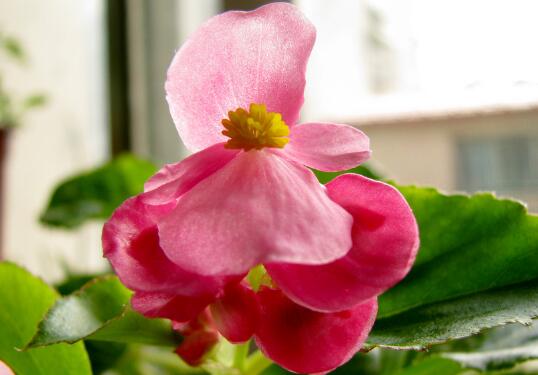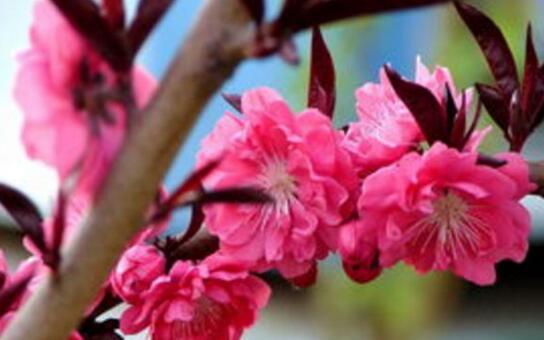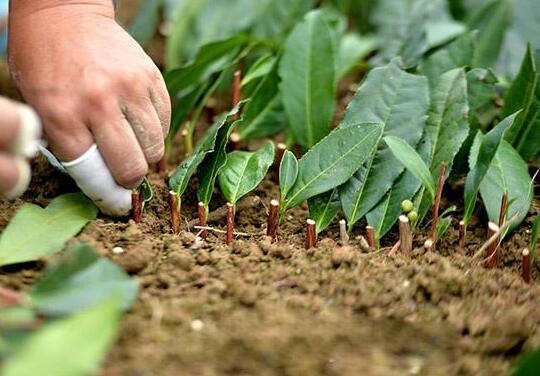How to propagate the four Seasons Begonia, the Propagation method / sowing / cutting of the four Seasons Begonia
Four Seasons Begonia is a kind of highly ornamental flower, and there are many people who breed it in our country. With more and more breeders, people are more concerned about its reproduction, so how to breed it? What are the breeding methods of Begonia in four seasons? Next, the editor will take you to learn about it.
First, how does the four Seasons Begonia reproduce

On how to reproduce crabapple in four seasons, in fact, it can be divided into two methods: sowing propagation and cutting propagation. As long as they are operated properly, the survival rate of the two methods is very high. In the following, there are two detailed teaching methods of reproduction. Interested friends can learn about it.
Second, the propagation method of four seasons begonia.
Sowing and reproduction
① seed prompting
Accelerating germination is a very important step about how to sow and reproduce the four seasons crabapple. Before sowing and propagating, we should first soak the seeds of the four seasons crabapple in warm water for about 12-24 hours. When the seeds begin to absorb water and swell, they can be taken out. This can promote the seeds of the four seasons crabapple.
② sowing method
In the breeding methods of four seasons crabapple, sowing reproduction is a more commonly used propagation method, first we need to mix the seeds and fine sand, then evenly sow on the soil surface, after sowing, cover about 1-2cm of soil, and then water, watering attention to thoroughly, but not stagnant water, the seeds can germinate about a week after watering.
Cuttage propagation
① cuttings selection
About the four seasons begonia how to cuttage propagation, the selection of cuttings is a very important step, it is generally best to choose more robust branches, so that the survival rate will be higher, if you choose to look very slender branches, then it is very difficult to survive. After selecting the cuttings, we need to cut the upper part into a flat top shape and the lower part into a horseshoe shape, which can expand the contact surface with the soil and promote rooting.
② cutting method
Among the propagation methods of begonia in the four seasons, cutting propagation is relatively simple. first of all, we can use chopsticks to cut a hole in the soil, so that the cuttings can be watered after inserting 2/3 into the soil. When watering, we should pay attention to watering thoroughly. Remember not to cause stagnant water, otherwise it is easy to cause root rot, and then it can take root in about 10-15 days.
The Cuttage method of four Seasons Begonia how to Cuttage Propagation
The propagation of Begonia in four seasons is mainly in three ways: sowing, cutting and dividing plants. if commercial cultivation, sowing propagation is used. The seeds of four seasons begonia are small and have a short life span. The seeds that naturally fall into the basin soil often germinate quickly and grow seedlings, but few seeds are harvested if they are not sown in time. Then how does the four seasons crabapple propagate by cutting? Today, the editor of wed114 wedding network brings you the relevant content of the cutting methods of four Seasons Begonia. Let's take a look.
Pictures of crabapple flowers in four seasons
First, brief introduction of four Seasons Begonia
Four seasons begonia, alias; four seasons begonia, clam crabapple, Latin name: Begonia semperflorens Link et Otto. Begonia, Begonia is a fleshy herb. Roots fibrous; stems erect, fleshy, glabrous, base much branched, leafy. Leaves ovate or broadly ovate, base slightly oblique, margin serrated and eyelashes, bright green on both sides, but main veins usually reddish. Originally from Brazil. Begonia is the most common and cultivated species of begonia. Graceful, delicate and bright leaves, flowers in clusters, blooming in the four seasons, and with a slight fragrance, is one of the main potted flowers for indoor and outdoor decoration. People apply it to the layout of flower beds, and the effect is excellent. With the emergence of some relatively heat-resistant varieties, Begonia is likely to become one of the most important flower beds in China, with the advantages of round plant type, many and dense flowers, easy to plant with other flower bed plants, long ornamental period and so on. so it's becoming more and more popular. It is generally cultivated in spring and autumn.
Pictures of crabapple flowers in four seasons
2. Cutting methods of begonia in four seasons.
1. Cutting time.
It is easy for begonia to take root in four seasons, but summer cutting is not recommended. At high temperature, it is often semi-dormant, so it is not easy for cuttings to survive, and it is easy to make cuttings rot, preferably in spring and autumn. Generally, you don't have to do special treatment, it's very simple. Family cutting should be carried out from April to May when the temperature rises to more than 20 ℃. At this time, the air humidity is high, the temperature is high, and the management is simple, which is suitable for the rapid rooting of begonia in the four seasons.
2. Selection of cuttings.
Cuttings generally choose robust growth, disease-free tip, length of about 5mur6 cm, that is, 3-4 nodes, each cuttings with at least 2 buds, cut 1 cm below the stem node of the cuttings, cut off leaves near the base, those with flower buds to remove flower buds, cut into a flat top shape, cut into horseshoe shape below, to expand the contact surface with sand, promote rooting, and then cut cuttings.
3. Cutting substrate.
Wash and dry the river sand and place it in a basin. The river sand washed and dried basically achieved the purpose of disinfection, and the sun-dried river sand was beneficial to the daytime sunshine temperature and promote the cuttings section healing and rooting.
4. Cutting and management.
Cut in the sand basin with a row spacing of 3 cm × 4 cm. When cutting, we first cut holes in the basin sand with bamboo sticks of the same thickness as the cuttings, and then insert the branches of four seasons crabapple, which do not need to be watered within 2 days after cutting, so as to facilitate the formation of healing tumors on the shear surface. On the fifth day, spray water with a temperature similar to that of sand, and pour it to the bottom of the basin to see the water flow out. Keep it in the shade and generally no longer water it. About 10 days can grow 3-4 cm root system, then put the pot in the sun, and watering according to the weather conditions, after 6-7 days, it can be planted in the basin.
Pictures of crabapple flowers in four seasons
Propagation methods of Begonia in three Seasons
Sowing method
East China is generally the most suitable in April-May in spring and August-September in autumn. The seeds should be evenly removed and sown on the fine mud in the basin (no need to cover the soil). Then use the sowing pot to absorb enough water, then cover a piece of glass and put it in a half-shaded place, which can sprout after 10 days. The seedlings sown in spring can blossom in the autumn of that year.
Cutting method
It can be carried out all the year round, but there are few branches after seedling, except for double-petal varieties, this method is not generally used to propagate.
Split-plant method
Perennial old plants can split them and prune them at the same time to promote the development of new lateral branches to form an intact plant shape.
Pictures of crabapple flowers in four seasons
Fourth, maintenance and management of crabapple in four seasons
Autumn crabapple of the four seasons has a long flowering period, many colors and rich changes, so it is a kind of beautiful flowers and leaves. It is not only suitable for outdoor cultivation such as gardens and flower beds, but also a good decoration for indoor family desks, coffee tables, desks and shop windows. After Qingming Festival, potted plants can be moved to outdoor shade for maintenance. East China should be maintained in full shade from April to October, but it is best to see a little sunlight in the morning and evening. If the leaves are found to be curled and scorched, this is a symptom of sunburn. After arriving at Frosts Descent, it is necessary to move into the indoor anti-freezing to keep warm, otherwise suffer frost, will freeze to death; indoor furnishings should be placed in the sunny place. If the room temperature lasts above 15 ℃ and topdressing is applied, it can still blossom.
Light, water, fertilizer, temperature and heart picking are the key to growing begonia in four seasons. After planting, the four seasons begonia can be exposed to direct sunlight in early spring, and should be properly shaded with the increase of sunshine.
At the same time, we should pay attention to the management of moisture, too much water is easy to produce rotten roots, rotten buds, rotten branches; high temperature and humidity are easy to produce various diseases. After planting slow seedlings, apply liquid fertilizer every 10 days. Timely pruning long branches and old branches to promote new lateral branches, strengthening pruning is conducive to the beauty of plant shape. The soil conditions of cultivation require neutral or slightly acidic soil rich in humus and good drainage, which is afraid of both drought and water stains.
How to propagate, the method of propagation / sowing propagation / cutting propagation of Begonia angustifolia
Antler Begonia is a succulent plant of the family Prunaceae, which comes from South Africa. Nowadays, it is cultivated all over China. As more and more people breed it all over the country, the question about its reproduction has also aroused people's concern. How does the antler begonia reproduce? What are the breeding methods of antler Begonia? Next, the editor will take you to learn about it.
1. How to reproduce, sow / cut Begonia angustifolia
When it comes to how to reproduce staghorn begonia, it is mainly divided into two methods: sowing reproduction and cutting propagation, in which sowing reproduction is more suitable for indoor potted plants, generally carried out in spring, while cutting propagation is generally used in mass planting, which can be carried out in both spring and autumn. As long as we operate properly, both methods have a higher survival rate, details below, let's take a look.
Second, the propagation method of Malus angustifolia.
First of all, whether it is sowing propagation or cutting propagation, we need to choose soil first, which is a good foundation, which is very important. Generally, it is best to choose loose and fertile sandy loam, which has good drainage and strong air permeability, which can make plants better absorb nutrients and is not prone to the phenomenon of stagnant water in basin soil.
Sowing and reproduction
Seed prompting: before we sow and reproduce the staghorn crabapple, we first need to urge its seeds. We can soak its seeds in warm water for about a day, and take them out when the seeds begin to absorb water and swell. This allows the seeds to germinate more quickly.
Sowing method: in the breeding method of staghorn begonia, sowing and reproduction is a commonly used method. First of all, we need to apply appropriate amount of base fertilizer in the basin soil, and then sow the seeds evenly on the soil surface. After sowing, we can cover the soil with 1-2cm for watering, pay attention to watering thoroughly when watering, and then germinate in about 10 days.
Cuttage propagation
Cuttage selection: before we cuttage, we need to choose cuttings first, generally, it is best to choose branches with stronger growth, so that the survival rate will be higher, if we choose branches that look very slender, then it is basically difficult to survive. After selecting the cuttings, we have to prune the leaves at the bottom and keep the upper 2-3 leaves.
Cutting method: in the propagation method of staghorn begonia, cutting propagation is a relatively simple method. First of all, we can use chopsticks to cut out a hole in the thickness of cuttings in the soil, and then pour water into the cuttings. This operation can avoid damage to the cuttings during insertion, which is very practical. We can take root in 15-20 days after the cuttings are finished.
- Prev

The propagation method / grafting / sowing of Prunus mandshurica can be used in how to reproduce.
The elm leaf plum has a strong ability to adapt to the environment, so it is not difficult to raise it, but when it grows for a certain period of time, it needs to consider its reproduction. Because the elm leaf plum belongs to the small tree of the subgenus Amygdalus of Rosaceae, the mode of reproduction is not only the same as that of some potted plants.
- Next

How to cut begonia in four seasons, the best cutting method is graphic / April-May cutting.
In the propagation methods of four seasons begonia, cutting propagation is a more commonly used method, and the survival rate is also relatively high, but the premise is that you have to master the correct operation method, so how to cut begonia? What is the diagram of the cutting method of Begonia in four seasons? Next, the editor will take you to learn about it.
Related
- Fuxing push coffee new agricultural production and marketing class: lack of small-scale processing plants
- Jujube rice field leisure farm deep ploughing Yilan for five years to create a space for organic food and play
- Nongyu Farm-A trial of organic papaya for brave women with advanced technology
- Four points for attention in the prevention and control of diseases and insect pests of edible fungi
- How to add nutrient solution to Edible Fungi
- Is there any good way to control edible fungus mites?
- Open Inoculation Technology of Edible Fungi
- Is there any clever way to use fertilizer for edible fungus in winter?
- What agents are used to kill the pathogens of edible fungi in the mushroom shed?
- Rapid drying of Edible Fungi

